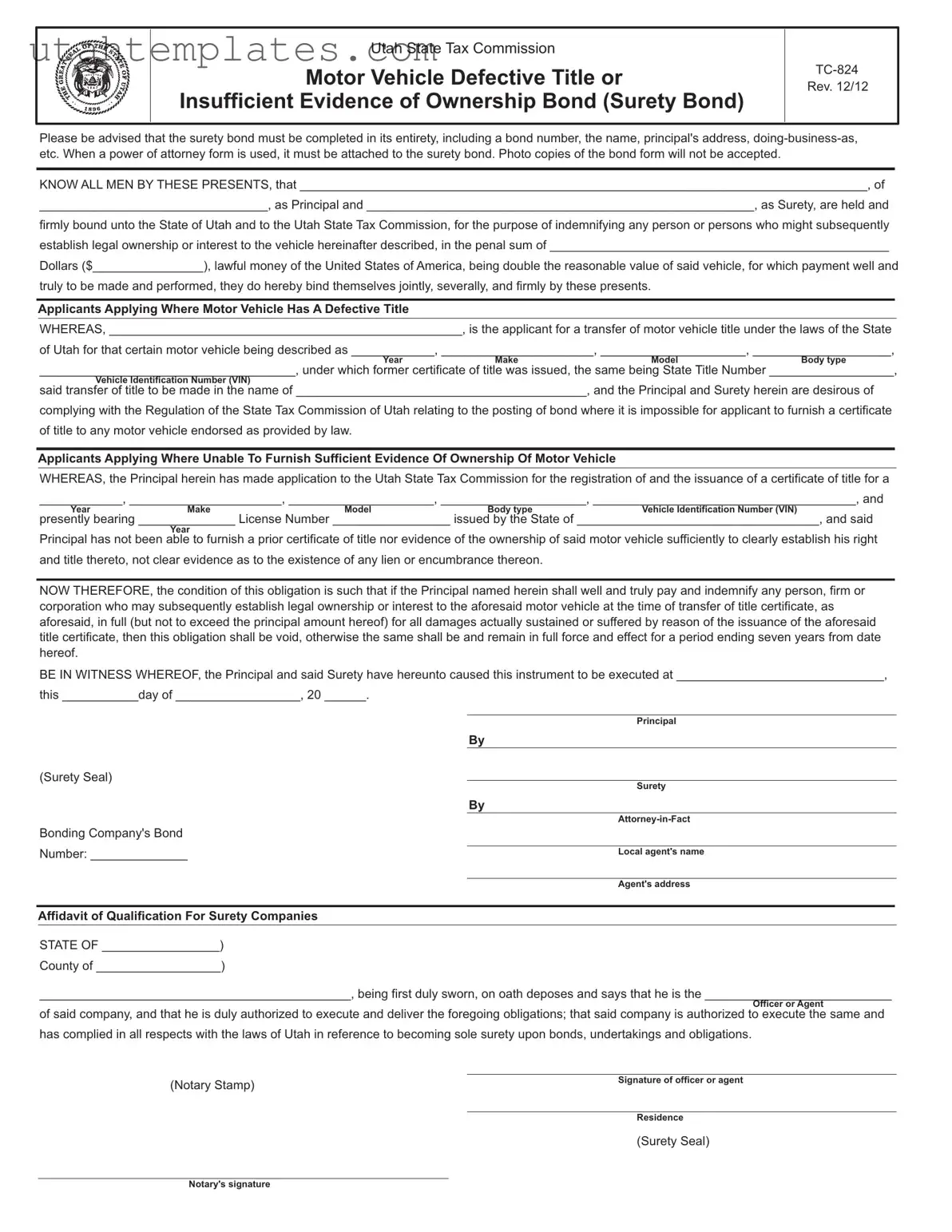Please be advised that the surety bond must be completed in its entirety, including a bond number, the name, principal's address, doing-business-as, etc. When a power of attorney form is used, it must be attached to the surety bond. Photo copies of the bond form will not be accepted.
KNOW ALL MEN BY THESE PRESENTS, that __________________________________________________________________________________, of
_________________________________, as Principal and ________________________________________________________, as Surety, are held and
firmly bound unto the State of Utah and to the Utah State Tax Commission, for the purpose of indemnifying any person or persons who might subsequently establish legal ownership or interest to the vehicle hereinafter described, in the penal sum of _________________________________________________
Dollars ($________________), lawful money of the United States of America, being double the reasonable value of said vehicle, for which payment well and
truly to be made and performed, they do hereby bind themselves jointly, severally, and firmly by these presents.
Applicants Applying Where Motor Vehicle Has A Defective Title
WHEREAS, ___________________________________________________, is the applicant for a transfer of motor vehicle title under the laws of the State
of Utah for that certain motor vehicle being described as ____________, ______________________, _____________________, ____________________,
YearMakeModelBody type
_____________________________________, under which former certificate of title was issued, the same being State Title Number __________________,
Vehicle Identification Number (VIN)
said transfer of title to be made in the name of __________________________________________, and the Principal and Surety herein are desirous of
complying with the Regulation of the State Tax Commission of Utah relating to the posting of bond where it is impossible for applicant to furnish a certificate
of title to any motor vehicle endorsed as provided by law.
Applicants Applying Where Unable To Furnish Sufficient Evidence Of Ownership Of Motor Vehicle
WHEREAS, the Principal herein has made application to the Utah State Tax Commission for the registration of and the issuance of a certificate of title for a
____________, ______________________, _____________________, _____________________, ______________________________________, and
YearMakeModelBody typeVehicle Identification Number (VIN)
presently bearing ______________ License Number _________________ issued by the State of ___________________________________, and said
Year
Principal has not been able to furnish a prior certificate of title nor evidence of the ownership of said motor vehicle sufficiently to clearly establish his right
and title thereto, not clear evidence as to the existence of any lien or encumbrance thereon.
NOW THEREFORE, the condition of this obligation is such that if the Principal named herein shall well and truly pay and indemnify any person, firm or corporation who may subsequently establish legal ownership or interest to the aforesaid motor vehicle at the time of transfer of title certificate, as aforesaid, in full (but not to exceed the principal amount hereof) for all damages actually sustained or suffered by reason of the issuance of the aforesaid title certificate, then this obligation shall be void, otherwise the same shall be and remain in full force and effect for a period ending seven years from date hereof.
BE IN WITNESS WHEREOF, the Principal and said Surety have hereunto caused this instrument to be executed at ______________________________,
this ___________day of __________________, 20 ______.
Principal
|
|
By |
|
(Surety Seal) |
|
|
Surety |
|
|
|
|
By |
|
|
Attorney-in-Fact |
|
Bonding Company's Bond |
|
|
|
|
|
Number: ______________ |
Local agent's name |
|
|
|
|
|
Agent's address |
Affidavit of Qualification For Surety Companies
STATE OF _________________)
County of __________________)
_____________________________________________, being first duly sworn, on oath deposes and says that he is the ___________________________
Officer or Agent
of said company, and that he is duly authorized to execute and deliver the foregoing obligations; that said company is authorized to execute the same and
has complied in all respects with the laws of Utah in reference to becoming sole surety upon bonds, undertakings and obligations.
(Notary Stamp) |
Signature of officer or agent |
|
|
|
|
Residence |
(Surety Seal)

